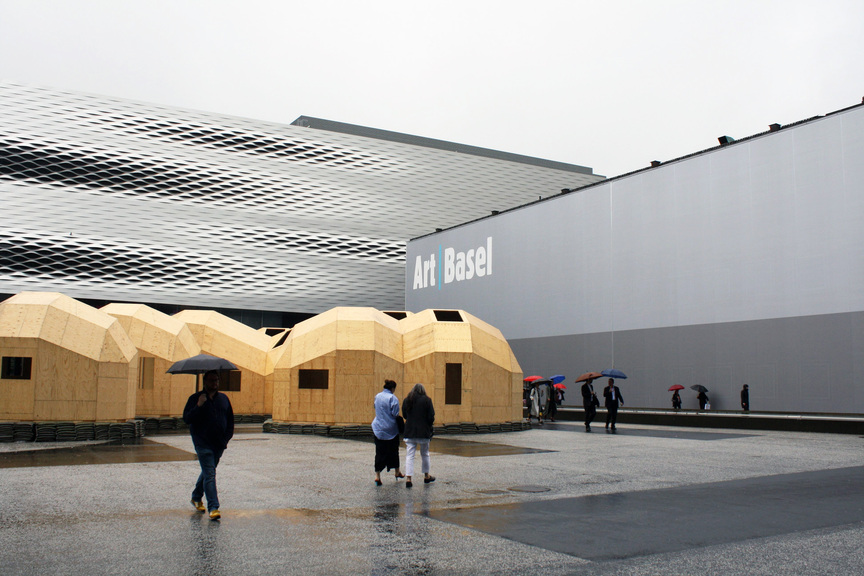Messeplatz with OSCAR TUAZON’s Zome Alloy (2016), a desultory adaption of Steve Baer’s “Zome House” (1972), which was an experimental form of modular and sustainable housing for desert living. Unfortunately the waterlogged structure was rather inhospitable in the cold, wet June weather during the opening two days. All photos in this article by HG Masters for ArtAsiaPacific.
The entrance to the Unlimited section, where 88 outsized projects were being displayed. This year’s section, curated by Gianni Jetzer, featured an even more international line-up of gigantic paintings, sculptures, installations and high-definition films, as well as performative works.
Big sculptures and big paintings are the bread and potatoes of the Unlimited section. Here, HAEGUE YANG’s Sol LeWitt Upside Down – Structure with Three Twowers, Expanded 23 Times, Split in Three (2015), which recalls a LeWitt work from 1986, was displayed in a new fashion: lower to the ground rather than suspended above viewers.
Recently the centerpiece of a monographic survey at the Helsinki Art Museum AI WEIWEI’s White House (2015), a 80-square-meter frame of residential building resurrected from the Qing Dynasty (1644–1911), was resting on glass orbs that reflected the colorful Frank Stella abstraction behind it.
A crowd-pleaser, CHIHARU SHIOTA’s suspended installation of red cords and old suitcases, Accumulation: Searching for Destination (2014–16), evoked the many individual stories behind voyages.
The Shanghai-based photography duo BIRDHEAD ’s (Ji Weiyu and Song Tao) Welcome to Birdhead World Again, Passions Bloom Ambitions from Vagina – 23 (2016), represents their working sentiment reflecting “the loneliness and void brought by the chaos, cold, and darkness in the human world [they] felt while growing up.”
MITHU SEN’s room-filling installation MOU (Museum of Unbelongings) (2016) is an “archive of vernacular culture,” in the words of critic Geeta Kapur, that houses a truly eclectic selection of collected talismans that evoke a surrealist’s pained, bodily worldview.
KOJI ENOKURA’s enormous Untitled No. 11 (1978) is created from wood, engine oil and white cloth, and measures 8-meters and 3.6-meters tall, respectively. The work reflects the Mono-ha group’s sensibility of using raw elements and contrasted those created by humans with natural materials in very direct, evident procedures.
PRABHAVATHI MEPPAYIL’s tw/one (2016), comprising 700 found objects in iron and brass tools used by goldsmiths, which are placed into a gridded formation on walls, draws from her family’s heritage of artisan practice.
RAYYANE TABET’s sculpture The Dead Sea in Three Parts (2013) is based on the volume of water between Israel, the Palestinian Territories and Jordan, and is cut into three parts, reflecting the 1947 United Nations Partition Plan that has still remained in place while also having fallen apart.
In HO TZU NYEN’s two versions of the film The Nameless (2015), the Sino-Vietnamese figure of Lai Teck—and aliases of the secretary general of Malayan Communist Party 1939–47–are played by the famous Hong Kong actor Tong Leung Chiu Wai from his films created from 1989–2013.
The square building of the Messe contains this inner circular courtyard, here seen in the rain, around which are two floors of international galleries bringing their best to what is, for contemporary art, still the year’s preeminent art air.
From Berlin, Barbara Wien gallery brought MICHAEL RAKOWITZ’s works from a recent show, JIMMIE DURHAM’s humorous objects, and this display of some vintage and new HAEGUE YANG works, including the sculpture in the corner, Millimeter Paper Fan (2007), and the lacquer-covered collage of millimeter paper, Obenbild (2000), with the newer Shiso Summer – Harvest bell sculpture in the foreground.
At PKM were these two heads by KWON JINKYU, entitled Woman with a Scarf (1969), and Jiwon (1967).
ATUL DODIYA’s history painting Arrival, October 9, 1947 (Diptych) (2015) created reclaimed city architecture on an adjoining canvas featuring prominently at Chemould Prescott Road’s booth.
At photography and conceptual art-focused Taka Ishii Gallery’s booth, YUKI KIMURA took a photograph by her grandfather of a Kyoto temple and turned it into an installation of her own, complete with potted palm tree. There are also a pair of found children’s chairs (like twins), by Kimura, and a photo emulsion on canvas by KUNIÉ SUGIURA behind them.
Take Ninagawa’s booth paired the bright red fabric cube of Gutai artist TSURUKO YAMAZAKI’s Red (Shape of Mosquito Net), from 1956, when many exhibitions were held in local Tokyo parks, to her Tin Cans (1955) in shiny magenta to the 1957 piece on the wall behind it.
At Urs Meile Gallery was this comic-cryptic painting, The Divine Anti-Japanese Goose No. 2 (2015) by WANG XINGWEI.
LANTIAN XIE’s solo booth at Grey Noise gallery featured the Dubai artist’s layered reflections on home and displacement, from the drawings on the wall of various hotels all named the Metropolitan, to objects like a collection of peacock mahjong tiles, fake Rolexes and a plastic sign from a newly arrived (in Dubai) Chinese restaurant.
Carroll Fletcher’s booth in the Statements section was given over to the duo of BASEL ABBAS and RUANNE ABOU RAHME, for their latest works And Yet My Mask is Powerful (2016) and Site Visit to Al-Nabi Yusha_17.04 (2016), on the floor.
In SARKIS ’s ‘La Chorégraphie avec des ’Trésors de Guerre’ (2016) at Galerie Nathalie Obadia, history plays out on a mirrored circle.
A portion of Vitamin Creative Space’s booth was reserved for CAO FEI’s videos and these robotic vacuum-cleaner-sculptures, seen in the current show at MoMA PS1 in New York.
While its interior walls were a matte black, Gavin Brown’s exterior played host to new, untitled drawings by RIRKRIT TIRAVANIJA (and helpers) of global protests, which is part of an ongoing series.
MONA HATOUM’s sculptures Kapan Iki (2012), fabricated originally in Turkey for an exhibition in Istanbul at Arter art space, occupied a prime corner spot at White Cube’s booth.




